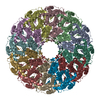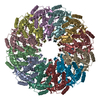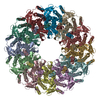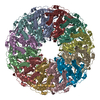+ データを開く
データを開く
- 基本情報
基本情報
| 登録情報 | データベース: PDB / ID: 6ppi | |||||||||||||||||||||||||||||||||||||||||||||
|---|---|---|---|---|---|---|---|---|---|---|---|---|---|---|---|---|---|---|---|---|---|---|---|---|---|---|---|---|---|---|---|---|---|---|---|---|---|---|---|---|---|---|---|---|---|---|
| タイトル | Kaposi's sarcoma-associated herpesvirus (KSHV), C12 portal dodecamer structure | |||||||||||||||||||||||||||||||||||||||||||||
 要素 要素 | Portal protein | |||||||||||||||||||||||||||||||||||||||||||||
 キーワード キーワード | VIRUS / portal / capsid / genome / genome packaging | |||||||||||||||||||||||||||||||||||||||||||||
| 機能・相同性 | Herpesvirus portal protein / Herpesvirus UL6 like / chromosome organization / virion component / host cell nucleus / Portal protein / Core gene UL6 family protein 機能・相同性情報 機能・相同性情報 | |||||||||||||||||||||||||||||||||||||||||||||
| 生物種 |   Human herpesvirus 8 (ヘルペスウイルス) Human herpesvirus 8 (ヘルペスウイルス) | |||||||||||||||||||||||||||||||||||||||||||||
| 手法 | 電子顕微鏡法 / 単粒子再構成法 / クライオ電子顕微鏡法 / 解像度: 4.7 Å | |||||||||||||||||||||||||||||||||||||||||||||
 データ登録者 データ登録者 | Gong, D. / Dai, X. / Jih, J. / Liu, Y.T. / Bi, G.Q. / Sun, R. / Zhou, Z.H. | |||||||||||||||||||||||||||||||||||||||||||||
| 資金援助 |  米国, 米国,  中国, 14件 中国, 14件
| |||||||||||||||||||||||||||||||||||||||||||||
 引用 引用 |  ジャーナル: Cell / 年: 2019 ジャーナル: Cell / 年: 2019タイトル: DNA-Packing Portal and Capsid-Associated Tegument Complexes in the Tumor Herpesvirus KSHV. 著者: Danyang Gong / Xinghong Dai / Jonathan Jih / Yun-Tao Liu / Guo-Qiang Bi / Ren Sun / Z Hong Zhou /   要旨: Assembly of Kaposi's sarcoma-associated herpesvirus (KSHV) begins at a bacteriophage-like portal complex that nucleates formation of an icosahedral capsid with capsid-associated tegument complexes ...Assembly of Kaposi's sarcoma-associated herpesvirus (KSHV) begins at a bacteriophage-like portal complex that nucleates formation of an icosahedral capsid with capsid-associated tegument complexes (CATCs) and facilitates translocation of an ∼150-kb dsDNA genome, followed by acquisition of a pleomorphic tegument and envelope. Because of deviation from icosahedral symmetry, KSHV portal and tegument structures have largely been obscured in previous studies. Using symmetry-relaxed cryo-EM, we determined the in situ structure of the KSHV portal and its interactions with surrounding capsid proteins, CATCs, and the terminal end of KSHV's dsDNA genome. Our atomic models of the portal and capsid/CATC, together with visualization of CATCs' variable occupancy and alternate orientation of CATC-interacting vertex triplexes, suggest a mechanism whereby the portal orchestrates procapsid formation and asymmetric long-range determination of CATC attachment during DNA packaging prior to pleomorphic tegumentation/envelopment. Structure-based mutageneses confirm that a triplex deep binding groove for CATCs is a hotspot that holds promise for antiviral development. | |||||||||||||||||||||||||||||||||||||||||||||
| 履歴 |
|
- 構造の表示
構造の表示
| ムービー |
 ムービービューア ムービービューア |
|---|---|
| 構造ビューア | 分子:  Molmil Molmil Jmol/JSmol Jmol/JSmol |
- ダウンロードとリンク
ダウンロードとリンク
- ダウンロード
ダウンロード
| PDBx/mmCIF形式 |  6ppi.cif.gz 6ppi.cif.gz | 881.7 KB | 表示 |  PDBx/mmCIF形式 PDBx/mmCIF形式 |
|---|---|---|---|---|
| PDB形式 |  pdb6ppi.ent.gz pdb6ppi.ent.gz | 717.4 KB | 表示 |  PDB形式 PDB形式 |
| PDBx/mmJSON形式 |  6ppi.json.gz 6ppi.json.gz | ツリー表示 |  PDBx/mmJSON形式 PDBx/mmJSON形式 | |
| その他 |  その他のダウンロード その他のダウンロード |
-検証レポート
| 文書・要旨 |  6ppi_validation.pdf.gz 6ppi_validation.pdf.gz | 1.1 MB | 表示 |  wwPDB検証レポート wwPDB検証レポート |
|---|---|---|---|---|
| 文書・詳細版 |  6ppi_full_validation.pdf.gz 6ppi_full_validation.pdf.gz | 1.1 MB | 表示 | |
| XML形式データ |  6ppi_validation.xml.gz 6ppi_validation.xml.gz | 116.4 KB | 表示 | |
| CIF形式データ |  6ppi_validation.cif.gz 6ppi_validation.cif.gz | 177.6 KB | 表示 | |
| アーカイブディレクトリ |  https://data.pdbj.org/pub/pdb/validation_reports/pp/6ppi https://data.pdbj.org/pub/pdb/validation_reports/pp/6ppi ftp://data.pdbj.org/pub/pdb/validation_reports/pp/6ppi ftp://data.pdbj.org/pub/pdb/validation_reports/pp/6ppi | HTTPS FTP |
-関連構造データ
- リンク
リンク
- 集合体
集合体
| 登録構造単位 | 
|
|---|---|
| 1 |
|
- 要素
要素
| #1: タンパク質 | 分子量: 68087.516 Da / 分子数: 12 / 由来タイプ: 天然 詳細: Subunit of portal complex present at KSHV's portal vertex; 12 copies constitute one dodecameric complex 由来: (天然)   Human herpesvirus 8 (ヘルペスウイルス) Human herpesvirus 8 (ヘルペスウイルス)株: GK18 / 参照: UniProt: Q76RH0, UniProt: F5HGK9*PLUS |
|---|
-実験情報
-実験
| 実験 | 手法: 電子顕微鏡法 |
|---|---|
| EM実験 | 試料の集合状態: PARTICLE / 3次元再構成法: 単粒子再構成法 |
- 試料調製
試料調製
| 構成要素 | 名称: Human gammaherpesvirus 8 / タイプ: VIRUS / Entity ID: all / 由来: NATURAL |
|---|---|
| 分子量 | 実験値: NO |
| 由来(天然) | 生物種:   Human gammaherpesvirus 8 (ヘルペスウイルス) Human gammaherpesvirus 8 (ヘルペスウイルス)株: BAC16 |
| ウイルスについての詳細 | 中空か: NO / エンベロープを持つか: YES / 単離: STRAIN / タイプ: VIRION |
| 天然宿主 | 生物種: Homo sapiens |
| ウイルス殻 | 名称: Capsid / 直径: 1250 nm / 三角数 (T数): 16 |
| 緩衝液 | pH: 7.4 |
| 試料 | 包埋: NO / シャドウイング: NO / 染色: NO / 凍結: YES |
| 試料支持 | グリッドの材料: COPPER / グリッドのタイプ: Quantifoil R2/1 |
| 急速凍結 | 装置: HOMEMADE PLUNGER / 凍結剤: ETHANE / 凍結前の試料温度: 298 K 詳細: The sample was manually blotted and frozen with a homemade plunger. |
- 電子顕微鏡撮影
電子顕微鏡撮影
| 実験機器 |  モデル: Titan Krios / 画像提供: FEI Company |
|---|---|
| 顕微鏡 | モデル: FEI TITAN KRIOS |
| 電子銃 | 電子線源:  FIELD EMISSION GUN / 加速電圧: 300 kV / 照射モード: FLOOD BEAM FIELD EMISSION GUN / 加速電圧: 300 kV / 照射モード: FLOOD BEAM |
| 電子レンズ | モード: BRIGHT FIELD / 倍率(公称値): 14000 X / 倍率(補正後): 24271 X / Cs: 2.7 mm |
| 試料ホルダ | 凍結剤: NITROGEN 試料ホルダーモデル: FEI TITAN KRIOS AUTOGRID HOLDER 最高温度: 79 K |
| 撮影 | 平均露光時間: 13 sec. / 電子線照射量: 25 e/Å2 フィルム・検出器のモデル: GATAN K2 SUMMIT (4k x 4k) 実像数: 8007 |
| 画像スキャン | サンプリングサイズ: 2.5 µm / 横: 1440 / 縦: 1440 / 動画フレーム数/画像: 26 |
- 解析
解析
| ソフトウェア |
| ||||||||||||||||||||||||||||||||||||||||||||
|---|---|---|---|---|---|---|---|---|---|---|---|---|---|---|---|---|---|---|---|---|---|---|---|---|---|---|---|---|---|---|---|---|---|---|---|---|---|---|---|---|---|---|---|---|---|
| EMソフトウェア |
| ||||||||||||||||||||||||||||||||||||||||||||
| CTF補正 | タイプ: PHASE FLIPPING AND AMPLITUDE CORRECTION | ||||||||||||||||||||||||||||||||||||||||||||
| 粒子像の選択 | 選択した粒子像数: 44328 | ||||||||||||||||||||||||||||||||||||||||||||
| 対称性 | 点対称性: C12 (12回回転対称) | ||||||||||||||||||||||||||||||||||||||||||||
| 3次元再構成 | 解像度: 4.7 Å / 解像度の算出法: FSC 0.143 CUT-OFF / 粒子像の数: 39073 / アルゴリズム: FOURIER SPACE / 対称性のタイプ: POINT | ||||||||||||||||||||||||||||||||||||||||||||
| 原子モデル構築 | B value: 200 / プロトコル: AB INITIO MODEL / 空間: REAL / Target criteria: Correlation coefficient | ||||||||||||||||||||||||||||||||||||||||||||
| 精密化 | 立体化学のターゲット値: GeoStd + Monomer Library | ||||||||||||||||||||||||||||||||||||||||||||
| 拘束条件 |
|
 ムービー
ムービー コントローラー
コントローラー


















 PDBj
PDBj